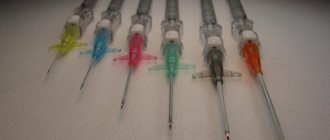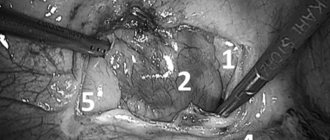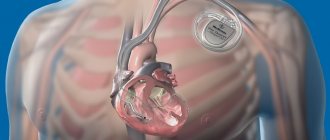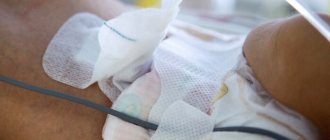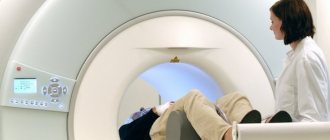Description
The central catheter is a long, thin tube that is inserted into a large vein. A central catheter is used to deliver medications, nutrition, intravenous drugs, and chemotherapy into the bloodstream.
There are different types of central catheters, including:
- Peripheral central catheter - the catheter is inserted through a vein in the arm until it reaches a vein close to the heart;
- A non-tunneled central venous catheter is inserted into a large vein in the neck or leg; the end of the tube is outside the skin.
- A tunneled catheter is a catheter that is secured in place when scar tissue forms. It can be used for several weeks or months. The catheter is inserted into a large vein in the neck, which returns blood to the heart. It is then advanced along the chest wall and removed through the skin at a distance of about 12 cm from the injection site into the vein.
- Port catheter - a device inserted into a vein in the shoulder or neck. A port (titanium chamber) is placed under the skin and a catheter is inserted into a central vein. To administer medications, the port membrane is pierced with a special needle, and for the next 3-5-7 days, any solutions in any quantities can be injected through this needle.
Advantages of port systems
- Implantable port systems provide reliable and safe access for intravenous infusions for many years.
- Port installation is performed on an outpatient basis and is painless for the patient.
- A small incision in the subclavian region heals quickly and does not require the removal of sutures.
- The light weight of the port creates convenience for the patient - after the procedure is completed and the needle is removed, the patient can easily return to an active lifestyle: shower, bath, play sports, swim in the pool, ski and even scuba dive.
- Excellent biocompatibility – minimal risk of port rejection.
- The titanium design of the camera in a plastic housing ensures long-term use and inertness of the port in tissues.
- A dense silicone membrane of large diameter helps to increase the service life of the device - the access begins to work from the first hours after implantation and functions up to 10-14 years.
- The port system does not contain latex, PVC or phthalates, which reduces the risk of infection.
Reasons for performing the procedure
A central catheter is inserted when the patient needs:
- Administer medications or fluids long-term;
- During chemotherapy;
- For nutrition, if food intake through the digestive system is impossible;
- Periodic blood sampling;
- Blood transfusion;
- For intravenous administration of drugs when the veins in the arm are difficult to access;
- For dialysis.
The central catheter is usually inserted by an interventional radiologist or vascular surgeon. Once inserted, the catheter can be used for several weeks to months.
Main indications for catheterization
The main therapeutic indications may be:
- chronic or acute forms of urinary retention as a result of constrictions, stones, tumors, pathologies (hyperplasia, nephrotuberculosis, glomerulonephritis);
- comatose or other helpless state of the patient;
- for the purpose of recovery after operations (patient rehabilitation);
- for disinfecting rinses, removal of blood or pus.
Common diagnostic uses of catheters include:
- installation for the purpose of monitoring the total amount of urine;
- to assess the general condition of the bladder, urethra;
- for the purpose of collecting urine during special studies;
- in preparation for examinations for administration of contrast agents.
Bladder catheterization is widely used in urological practice both to make the patient’s life easier and to obtain reliable data during examinations.
Possible complications after insertion of a central catheter
Complications are rare, but no procedure is guaranteed to be risk-free. Before you install a central catheter, you need to be aware of possible complications, which may include:
- Bloodstream infections, when bacteria enter the bloodstream through or around the central line;
- Bleeding;
- Lung collapse;
- Arrhythmia (unstable heartbeat);
- Nerve damage;
- An air bubble or part of the catheter may block blood vessels, causing chest pain, shortness of breath, dizziness, and rapid heartbeat;
- Blood clots in a vein or catheter can block blood flow.
Factors that may increase the risk of complications include:
- Smoking;
- Difficult access to veins;
- Blood clots;
- Obesity;
- Broken bones;
- Infection;
- Poor blood circulation;
- Bleeding tendencies.
How is a central catheter inserted?
Preparation for the procedure
- A blood test may be done to check blood clotting;
- The doctor may ask about allergies;
- You need to arrange a trip home after the procedure;
- The patient may be asked to stop taking certain medications a week before the procedure: Aspirin or other anti-inflammatory drugs;
- blood thinners such as clopidogrel or warfarin;
Anesthesia
The area where the catheter will be inserted is numbed with local anesthesia. Depending on where the central catheter will be inserted, a sedative may be given intravenously.
Description of the procedure for inserting a central catheter
This procedure can be done either in a hospital as part of treatment or on an outpatient basis.
Having a catheter increases the risk of bloodstream infection. Hospital staff should perform the procedure while taking the following steps to reduce this risk:
- Care must be taken to select a safe place to insert the catheter;
- Wash your hands thoroughly or use hand sanitizer;
- You must wear surgical gowns, masks, gloves, and cover your hair;
- Cleanse the skin with an antiseptic;
- Use a sterile drape.
The next steps may vary depending on the type of catheter and where it is inserted. In general, staff will do the following:
- Anesthesia is administered;
- A small incision is made;
- X-rays or ultrasound are used to guide the catheter into the vein;
- Before installing the catheter, you need to cut it to the desired length. The catheter is flushed with saline (salt water);
- The catheter is guided using a catheter guide. The conductor is then removed;
- The catheter is secured to the skin (usually with adhesive tape). A cap is placed on the end of the catheter;
- A bandage is applied to the catheter insertion site. The date of insertion is marked on or near the bandage.
If a port catheter is inserted, a small cavity is made under the skin to accommodate it. The incision will be closed, usually with absorbable suture.
Immediately after the procedure
The insertion site will be checked for bleeding, fluid leakage, and swelling.
Classification
Intravenous catheters are classified according to many criteria.
By purpose
There are two types: central venous (CVC) and peripheral venous (PVC).
CVCs are designed for catheterization of large veins, such as the subclavian, internal jugular, and femoral. Using this instrument, medications and nutrients are administered and blood is drawn.
PVC is installed in peripheral vessels. As a rule, these are the veins of the extremities.
Comfortable butterfly catheters for peripheral veins are equipped with soft plastic wings with which they are attached to the skin
The “butterfly” is used for short-term infusions (up to 1 hour), since the needle is constantly in the vessel and can damage the vein if held longer. They are usually used in pediatrics and outpatient practice for puncturing small veins.
By size
The size of venous catheters is measured in gaits and is designated by the letter G. The thinner the instrument, the larger the gaits value. Each size has its own color, the same for all manufacturers. The size is selected depending on the application.
| Size | Color | Application area |
| 14G | Orange | Rapid infusion of large volumes of blood products or fluids |
| 16G | Grey | Transfusion of large volumes of blood or fluids |
| 17G | White | Transfusion of large volumes of blood or fluids |
| 18G | Green | Routine red blood cell transfusion |
| 20G | Pink | Long courses of intravenous therapy (two to three liters per day) |
| 22G | Blue | Long courses of intravenous therapy, oncology, pediatrics |
| 24G | Yellow | Sclerotic veins, pediatrics, oncology |
| 26G | Violet | Sclerotic veins, pediatrics, oncology |
By model
There are ported and non-ported catheters. Ported ones differ from non-ported ones in that they are equipped with an additional port for introducing liquid.
By design
Single-channel catheters have a single channel and end in one or more holes. They are used for periodic and continuous administration of medicinal solutions. They are used for both emergency care and long-term therapy.
Multichannel catheters have from 2 to 4 channels. Used for simultaneous infusion of incompatible drugs, blood collection and transfusion, hemodynamic monitoring, and visualization of the structure of blood vessels and the heart. They are often used for chemotherapy and long-term administration of antibacterial drugs.
By material
| Material | pros | Minuses |
| Teflon |
|
|
| Polyethylene |
|
|
| Silicone |
|
|
| Elastomeric hydrogel |
|
|
| Polyurethane |
| |
| PVC (polyvinyl chloride) |
|
|
Caring for the patient after the central catheter insertion procedure
Hospital care
After the procedure, staff may provide the following assistance to aid recovery:
- An x-ray is taken to ensure that the catheter is in the correct position;
- The catheter insertion site is periodically checked for bleeding;
- Medicines, fluids, or nutritional solution are given through the catheter;
- The port catheter is flushed to prevent blood clots;
- Steps are taken to reduce the risk of infection: Wash your hands and gloves thoroughly before touching the catheter or changing the dressing;
- An antiseptic is used to clean the exposed parts of the catheter;
- Precautions are taken when handling medications, fluids, or foods that will be administered through the catheter;
- The patient is monitored for signs of infection, which include fever, chills, and problems at the insertion site (eg, redness, swelling, drainage);
- Visitors should not be in the hospital room when the dressing is changed;
- The catheter remains at the insertion site as long as necessary.
There are also steps you can take to reduce your risk of infection:
- Employees should be asked to take all precautions to prevent infection;
- Personnel should immediately alert the physician if there is redness or pain at the catheter insertion site;
- You must wash your hands before entering the room. Visitors should not be allowed to touch the catheter.
Home care
When you return home, you should do the following to ensure a normal recovery:
- The insertion site should be kept clean, dry and bandaged. When changing the dressing, follow the doctor's instructions;
- You should wash your hands or use hand sanitizer before touching the catheter;
- You should ask your doctor about when it is safe to shower, swim, or expose the surgical site to water;
- Do not swim or bathe with a central catheter inserted;
- Any activity that could weaken the central catheter should be avoided;
- No one should touch the catheter;
- The injection site should be checked every day for signs of infection (eg, redness, pain);
- The catheter should be flushed with saline or heparin as directed by your doctor.
